Fluid art is wildly popular because it’s a thrilling blend of science and creativity, giving people the chance to craft stunning, one-of-a-kind pieces. Imagine swirling vibrant paint into mesmerizing patterns, guided by gravity and fluid dynamics—it’s like being a mad scientist and an artist all at once! This method allows for spontaneous, unpredictable results, sparking joy and excitement with each creation. Workshops and online communities make it easy to learn, share, and connect with fellow art lovers. Plus, the therapeutic benefits of this art form can’t be overstated, offering a calming escape from everyday stress. Curious about diving deeper into this colorful world?
Key Takeaways
- Fluid art’s unpredictability and spontaneity make each piece unique, attracting artists and audiences alike.
- The simplicity of techniques like dirty pour and balloon smash allows beginners to create stunning art without extensive training.
- Fluid art workshops and online communities foster collaboration and support, enhancing the sense of belonging among artists.
- The therapeutic benefits, including stress reduction and enhanced cognitive function, make fluid art appealing for mental well-being.
Definition and Historical Context
Fluid Art, also known as pour painting, is an artistic technique that uses free-flowing paint to create organic and abstract forms, with origins dating back to the experimental works of David Alfaro Siqueiros in the 1930s. This innovative approach, initially termed ‘accidental painting‘ by Siqueiros, marked a significant milestone in the artistic evolution of abstract art. By allowing the paint to move freely, Siqueiros and later artists like Jackson Pollock embraced the unpredictability of fluid dynamics to achieve spontaneous and unique results.
The cultural significance of Fluid Art is profound. It democratizes the creative process, making art accessible to everyone, not just trained artists. Techniques such as clean pour, dirty pour, flip cup, and swipe have emerged from this movement, each enabling a different form of expression and creativity. This artistic method has resonated with people globally, fostering a sense of community among enthusiasts who share their creations and techniques.
The rise in popularity of Fluid Art can also be attributed to its therapeutic benefits. The process of pouring and manipulating paint allows for a meditative escape, encouraging both amateur and professional artists to explore and enjoy the art form.
Physics and Chemistry
Imagine mixing paints and watching them swirl together, only to see some colors float while others sink—that’s the magic of paint density in fluid art!
When you add special ingredients like Floetrol or silicone, you can create stunning cell formations that look like tiny galaxies.
The chemistry behind these interactions is like a science experiment, producing unique patterns and textures that make each piece truly one-of-a-kind.
Paint Density Effects
The density of paint plays a pivotal role in determining how pigments layer and interact during the pouring process, influencing the visual outcome of fluid art compositions. Density variations are key to creating the dynamic and intricate patterns that characterize this art form. In fluid art, lighter pigments typically float on top of heavier ones, allowing artists to employ specific layering techniques to achieve their desired effects.
Understanding the density of various pigments can help artists predict how different colors will interact on the canvas. For example, a density chart, such as the one provided by GOLDEN Artist Colors, assists in selecting pigments based on their specific weights. This enables artists to strategically plan their pours for maximum visual impact.
Temperature and humidity also play a role in paint density, subtly affecting how paints flow and settle. A cooler environment might make the paint thicker, while a warmer setting could make it more fluid. As a result, artists need to take into account environmental conditions to maintain consistency in their work.
Mastering the science behind paint density allows fluid artists to push creative boundaries, resulting in mesmerizing compositions with layered depth and texture.
Additives and Cell Formation
Through the incorporation of additives such as silicone oil and treadmill belt lubricant, artists can manipulate paint surface tension to create dynamic cell formations in fluid art. The science behind this involves the careful balance of paint density and the reduction of surface tension, which allows different paint layers to separate and form unique patterns.
Additive experimentation is key to achieving the desired effects. Different ratios of paint to additives can drastically alter the outcome, leading to intriguing and varied cell formations.
Here are three key aspects to reflect upon:
- Additive Ratios: Experimenting with different amounts of silicone oil or lubricant can create larger or smaller cells, providing a wide range of artistic possibilities.
- Paint Density: Lighter pigments will float on heavier ones, so understanding and controlling the density of your paint layers is essential for distinct cell formation.
- Environmental Factors: Temperature and humidity can influence how paints interact, making it important to be mindful of your workspace conditions for consistent results.
Understanding the physics and chemistry behind these interactions allows artists to fine-tune their techniques, resulting in mesmerizing fluid art pieces that captivate viewers.
Essential Supplies
Essential supplies for fluid art include disposable gloves, clear plastic cups for mixing, coffee stir sticks for stirring, and a digital scale for precise paint measurements. Glove selection is vital to protect hands from paint and chemicals, making certain a hassle-free creative process. Clear plastic cups facilitate easy paint mixing and visibility, while coffee stir sticks are ideal for thorough blending. A digital scale offers accuracy in paint measurement, guaranteeing consistency in color mixing.
A dedicated paint pour box helps contain spills and provides a controlled environment for experimenting with different techniques. High-quality professional-grade paints are preferred for vibrant results, while student-grade paints offer an economical alternative. Common additives like Floetrol, silicone, and diluted PVC glue enhance paint flow and create mesmerizing cell patterns. Various surfaces—such as canvas or wood panels—affect the final look of the artwork.
Here is a quick reference table of essential supplies:
| Supply | Purpose |
|---|---|
| Disposable Gloves | Hand protection during painting |
| Clear Plastic Cups | Mixing and pouring paint |
| Coffee Stir Sticks | Stirring paint mixes |
| Digital Scale | Accurate paint measurement |
| Paint Pour Box | Containing spills, controlled pouring |
These essentials make certain a smooth and enjoyable fluid art experience, laying the foundation for stunning, unique creations.
Popular Techniques
Fluid art enthusiasts often experiment with different techniques to achieve mesmerizing effects, and two of the most popular methods are dirty pour and balloon smash.
The dirty pour method involves combining multiple colors in a single cup and then pouring them out to create intricate, swirling patterns.
On the other hand, the balloon smash technique adds a playful twist by pressing a paint-coated balloon onto the canvas, resulting in fun, round shapes and vibrant cells.
Dirty Pour Method
Have you ever wondered how artists achieve the mesmerizing, marbled effects in fluid art? The answer often lies in the Dirty Pour method, a popular technique that involves layering multiple colors of paint in a single cup before pouring it onto the canvas. This method allows for stunning color combinations and works well on various canvas types, from stretched canvases to canvas boards.
Imagine the process in three steps:
- Layering the Cup: Artists start by pouring different colors of paint into a single cup, carefully choosing color combinations to create a harmonious blend.
- The Pour: They then pour the contents of the cup onto the canvas in one fluid motion, allowing the paints to mix and flow naturally.
- Tilting and Manipulating: Finally, the artist tilts and moves the canvas to guide the paint, creating unique patterns and organic designs.
The Dirty Pour method offers greater control over color blending and produces results that are difficult to replicate, ensuring each piece is unique.
Balloon Smash Technique
The Balloon Smash technique offers artists a playful yet effective way to create textured and vibrant patterns on their canvases. Imagine dipping a balloon into colorful puddles of paint and then gently pressing it onto the canvas. Sounds fun, right? This method is super popular because it lets artists explore different color combinations and effects without needing to be super precise.
One of the coolest things about Balloon Smash is the flexibility it offers. You can use a base coat of paint to make the colors pop even more. Plus, by changing the size of the balloon or the amount of paint you use, you can get all sorts of interesting textures and designs. This balloon variation makes each piece unique!
Artists often combine Balloon Smash with other fluid art techniques like pouring and swiping. This layering creates depth and intricate patterns that make the artwork even more enchanting. It’s like a colorful adventure in color exploration!
Preparation and Workshops
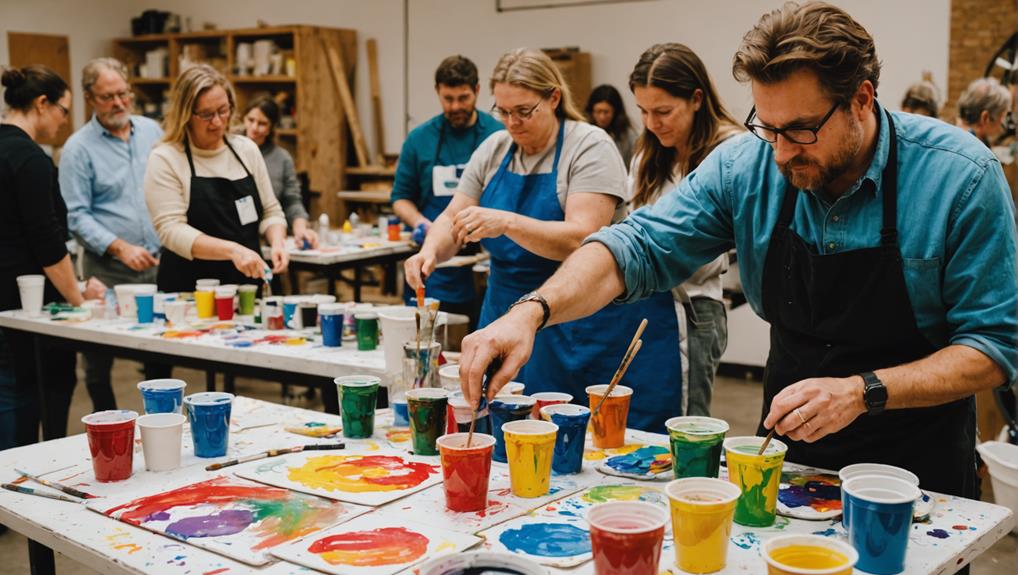
Proper preparation underpins the success of fluid art, necessitating an understanding of paint chemistry, surface priming, and color theory. Fluid art workshops play an essential role in equipping participants with vital preparation techniques. These workshops offer numerous benefits, especially for beginners.
Firstly, workshops provide hands-on experience under the guidance of experienced instructors, allowing participants to master various techniques and processes. This personalized attention guarantees that each participant can develop their skills effectively.
- Personalized Learning: Workshops typically limit the number of participants to around four students, guaranteeing that everyone receives individualized guidance and support.
- All-Inclusive Materials: All necessary materials are provided, making it easy for beginners to plunge into fluid art without the need for prior investment in supplies.
- Community Building: Workshops foster a sense of community, encouraging participants to share their experiences and creativity. This collaborative environment enhances the learning process, making it both enjoyable and enriching.
Understanding the nuances of paint chemistry, surface priming, and color theory through these workshops not only improves one’s artistic outcomes but also builds confidence in experimenting with different fluid art techniques. These preparatory steps are fundamental to achieving the mesmerizing effects that make fluid art so enthralling.
Learning Resources
Learning Fluid Art has never been more accessible, thanks to a multitude of resources available online.
Instructional videos by renowned artists like Mixed Media Girl and Olga Soby provide step-by-step guidance on various techniques, while one-day workshops offer hands-on experiences for those seeking more personalized instruction.
Additionally, online platforms, community forums, and social media groups create a vibrant space for artists to share tips, learn from each other, and continually refine their skills.
Instructional Video Platforms
Instructional video platforms frequently offer a wealth of tutorials on fluid art techniques, catering to both novices and seasoned artists. Websites like YouTube make learning accessible with channels such as Mixed Media Girl and Olga Soby, which provide step-by-step guides.
These video tutorials cover essential methods like acrylic pouring, swiping, and balloon smash techniques, making it easy for anyone to get started.
One of the significant benefits of these platforms is the engaging visual format, which allows for better comprehension of complex processes. Through video tutorials, artists can see the nuances of fluid art creation in real-time, enhancing their ability to replicate these techniques at home.
Additionally, these platforms often include tips on selecting the right materials, pouring mediums, and additives.
Being part of online communities on these platforms can also be incredibly beneficial. Artists can share their work, ask questions, and get feedback, making the learning process both interactive and supportive.
Here are three reasons why instructional video platforms are so effective:
- Visual Learning: Step-by-step guides help demystify complex techniques.
- Accessible Resources: Tips on materials and methods guarantee successful replication.
- Community Support: Engaging with fellow artists fosters a collaborative learning environment.
Popular Art Workshops
Popular art workshops specializing in fluid art techniques offer invaluable hands-on experience with diverse pouring methods, such as dirty pours and flip cups, to create stunning visual effects. These workshops are a fantastic way to immerse yourself in the world of fluid art, providing a unique blend of artistic expression and creative collaboration. Typically, these sessions are kept small, with around four students per class, ensuring that everyone gets personalized attention and guidance from experienced instructors.
In these workshops, participants learn about essential materials like different types of paints and pouring mediums, which play a significant role in the final look of their artwork. The community aspect of these gatherings is a highlight, allowing attendees to share ideas, experiences, and even some laughs, fostering a sense of camaraderie and mutual inspiration.
Moreover, many workshops integrate online resources and video tutorials, giving participants an all-encompassing learning experience. These digital tools reinforce the techniques learned in class and inspire further exploration in fluid art.
Whether you’re a seasoned artist or a curious beginner, these workshops offer an engaging, hands-on way to explore your creativity and connect with others who share your passion for fluid art.
Community Engagement
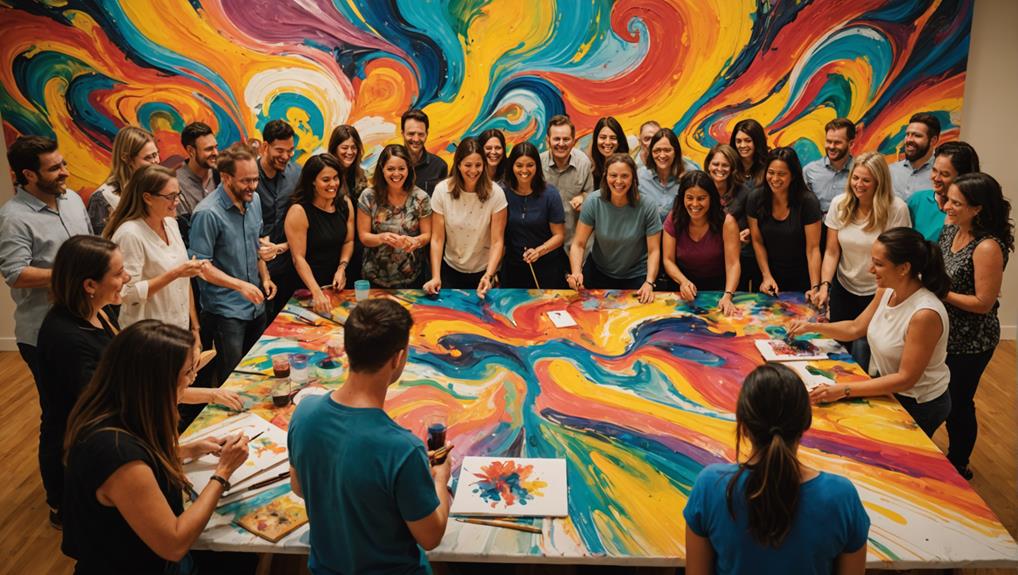
Fostering creativity and shared experiences, community engagement in fluid art encourages collaboration and support among artists of all skill levels. This vibrant community collaboration not only strengthens artistic support but also cultivates a nurturing environment where creativity can thrive. Fluid art communities offer a multitude of ways for artists to connect and grow together.
- Workshops and Classes: These events provide invaluable opportunities for individuals to meet and bond over their shared passion for fluid art. By participating in hands-on activities, artists can learn new techniques from seasoned professionals and exchange ideas, fostering both personal and artistic growth.
- Online Platforms and Social Media: The digital era has made it easier than ever for artists to showcase their work, share tips and techniques, and engage with a global audience. Platforms like Instagram and Facebook host thriving communities where fluid artists can receive feedback and encouragement from peers and admirers alike.
- Community Events and Exhibitions: Local events and exhibitions spotlight the diverse talents within the fluid art scene, offering artists a platform to display their unique creations. These gatherings not only promote artistic appreciation but also strengthen social bonds among participants, fostering a sense of belonging and mutual support.
Through these avenues, fluid art communities continue to grow, bringing together artists from all walks of life.
Artistic Freedom
Fluid art exemplifies artistic freedom by liberating artists from the constraints of traditional techniques, enabling them to explore their creativity without boundaries. This form of art encourages artistic expression by allowing artists to experiment freely, creating unique and personal masterpieces. Unlike conventional methods that demand precision, fluid art prioritizes creative liberation, letting artists focus on the joy and spontaneity of the process.
Techniques such as pouring, swiping, and balloon smashing offer endless possibilities, empowering artists to explore various methods without the fear of making mistakes. This freedom not only enhances their confidence but also adds an element of fun to their artistic journey. Each piece of fluid art is a reflection of the artist’s individuality, capturing their emotions and thoughts in vibrant, unpredictable patterns.
The absence of strict rules in fluid art means that the resulting pieces are always fresh and original, reflecting the artist’s true self. This dynamic nature captivates both the creator and the audience, promoting a culture of exploration and innovation. By breaking free from traditional constraints, fluid art fosters an environment where creativity can flourish, making it an immensely popular and fulfilling form of artistic expression.
Therapeutic Benefits
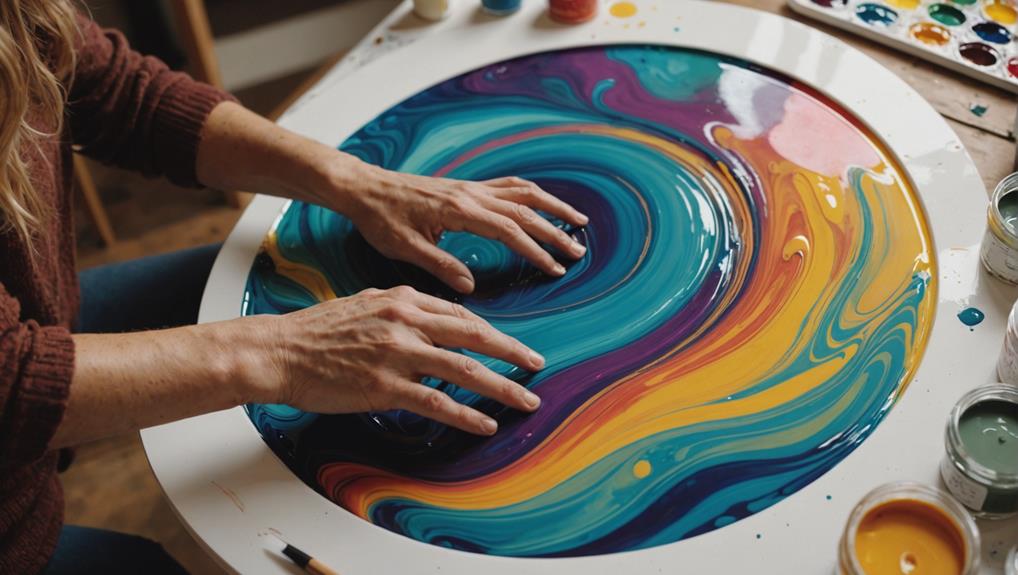
Engaging in fluid art can serve as a therapeutic outlet, offering significant benefits for mental and emotional well-being.
When individuals immerse themselves in the process of fluid painting, they often find it to be a powerful mindfulness practice. This art form requires a level of focus that helps people stay present in the moment, reducing stress and anxiety.
Moreover, fluid art allows for deep emotional expression. The act of pouring and manipulating paint can be incredibly freeing, allowing artists to channel their feelings into their work. This not only relieves pent-up emotions but also boosts mood by stimulating the release of dopamine, a neurotransmitter associated with pleasure and reward.
Here are three key therapeutic benefits of fluid art:
- Mindfulness Practice: The required concentration helps individuals stay in the present, offering a mental break from daily stresses.
- Emotional Expression: Fluid art serves as a creative outlet for expressing emotions that might be difficult to articulate otherwise.
- Enhanced Cognitive Functions: The creative process involved in fluid art promotes problem-solving and critical thinking, encouraging exploration and experimentation.
Social Media Influence
The rise of social media platforms has considerably amplified the visibility and popularity of fluid art, transforming it into a global phenomenon. The vibrant and visually striking nature of fluid art makes it highly shareable, attracting a wide audience keen for engaging content. Artists like Crystal Ma utilize Instagram to showcase their fluid art processes, gaining followers through enchanting videos and unique styles.
Social media trends, particularly on TikTok and Instagram, have led to a surge in fluid art challenges. These viral trends encourage users to participate and share their creations, fostering a sense of community and collaboration among artists. The accessibility of fluid art techniques allows beginners to easily create and share their artwork online, contributing to audience engagement and a growing network of enthusiasts.
Hashtags related to fluid art, such as #FluidArt and #AcrylicPouring, help connect artists and enthusiasts. This creates a global network of individuals passionate about this art form. The table below highlights key aspects of social media’s influence on fluid art:
| Platform | Key Influence | Example |
|---|---|---|
| Increased visibility | Crystal Ma’s enchanting videos | |
| TikTok | Viral trends | Fluid art challenges |
| Hashtags | Community building | #FluidArt, #AcrylicPouring |
Emotional and Cognitive Impact
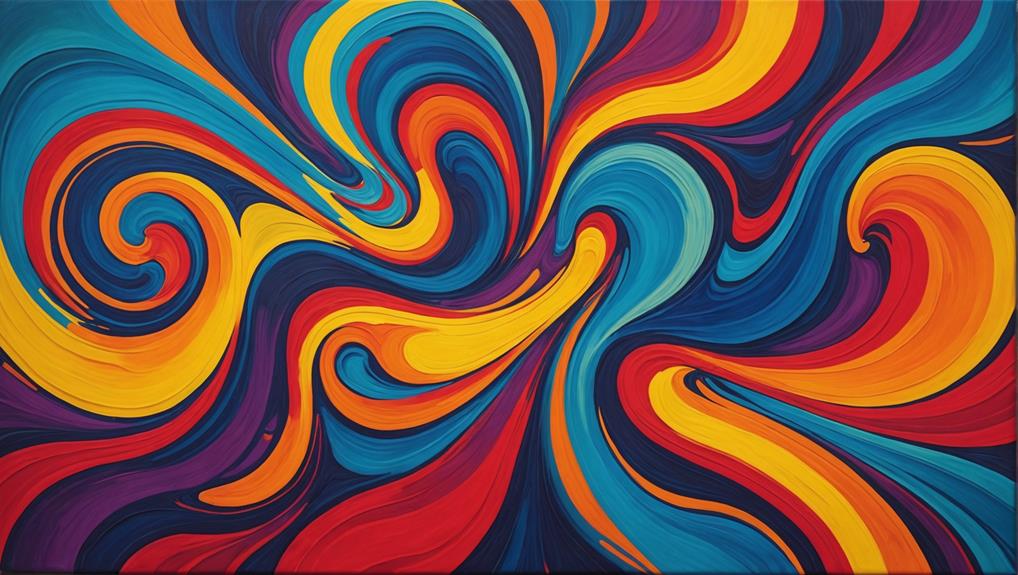
Many individuals find that fluid art serves as a therapeutic outlet, enabling them to process emotions and experience relaxation through the creative process. This form of art offers a powerful means of emotional release, helping to reduce stress and alleviate symptoms of anxiety and depression. The act of blending colors and watching them flow across the canvas can be incredibly soothing, providing a sense of calm and well-being.
Moreover, engaging in fluid art can greatly boost cognitive development. As artists experiment with different techniques and materials, they enhance their problem-solving and critical thinking skills. The unpredictability of fluid art requires artists to adopt a mindset of exploration and flexibility, which can improve resilience and adaptability in both artistic endeavors and everyday life.
Research indicates that creating art can lead to improved mental health outcomes by offering a means of self-expression. Here are some ways fluid art impacts emotional and cognitive well-being:
- Stress Reduction: The creative process can lower stress levels and foster relaxation.
- Problem-Solving Skills: Experimenting with techniques enhances critical thinking.
- Resilience: Embracing unpredictability fosters adaptability and emotional strength.
Success Stories
Franchisees within the Hawaii Fluid Art community have experienced remarkable personal and financial growth, illustrating the effectiveness of the business model. Many have shared their unique art styles and techniques, inspiring others to immerse themselves in fluid art. This franchise success is not just about numbers, though; it’s also about the heartwarming community connections that have been formed.
Take, for example, Sarah, a franchisee who decided to bring her love for the ocean into her fluid art pieces. Her workshops quickly became a hit, not just because of her stunning artwork but also due to the sense of community she fostered. Participants often leave her sessions feeling more connected and inspired, a demonstration of the power of art to bring people together.
Moreover, the Hawaii Fluid Art community thrives on collaboration. Franchisees frequently exchange ideas and support each other, leading to innovative approaches in fluid art practices. This supportive network has been a cornerstone of their collective success, making the entire experience enriching both personally and professionally.
Exploring Creativity
Engaging in fluid art offers an unparalleled opportunity for spontaneous creativity, inviting artists to embrace experimentation and unpredictability. This form of artistic expression thrives on the unexpected, as the movement of paint on the canvas can create unique and mesmerizing patterns.
Artists find immense joy in the process of artistic exploration, where the final creation is often a delightful surprise. Fluid art encourages individuals to let go of the pursuit of perfection and instead focus on the journey of creation. This liberating experience can be quite therapeutic, providing a calming outlet for emotional processing and stress relief.
Here are some vivid aspects of fluid art that paint a picture of its creative potential:
- Vibrant Colors: The striking and dynamic hues captivate both creators and viewers, sparking inspiration and curiosity.
- Dynamic Patterns: The swirling and flowing designs often evoke a sense of movement and energy, allowing for endless possibilities.
- Inclusive Techniques: Methods like pouring and swiping are accessible to artists of all skill levels, fostering a welcoming community.
Frequently Asked Questions
Why Is Fluid Art so Popular?
Fluid art trends have surged in popularity due to their accessibility, allowing for creative expression without traditional constraints. The enchanting visuals and therapeutic benefits also contribute to its widespread appeal, particularly through social media and community workshops.
What Are the Benefits of Fluid Art Painting?
The benefits of fluid art painting include fostering creative expression and providing significant stress relief. This art form encourages experimentation with colors and techniques, enhancing emotional well-being and cognitive skills through a therapeutic and engaging creative process.
How Do You Describe Fluid Art?
Fluid art, characterized by fluid techniques such as acrylic pouring and swiping, promotes artistic expression through the creation of organic, dynamic patterns. This abstract art form allows artists to explore spontaneous creativity, producing unique and enchanting visual effects.
Why Is Pop Art so Popular?
Pop Art remains popular due to its integration of pop culture and vibrant artistic expression, making it accessible and engaging. Its use of recognizable imagery and commentary on consumerism continues to resonate with contemporary audiences.
Conclusion
Fluid art has garnered widespread popularity due to its vibrant, dynamic nature and the accessibility of its techniques.
Combining elements of physics and chemistry, it offers a unique creative outlet that appeals to a broad audience.
The rise of social media has further propelled its visibility, while workshops and community events have fostered a collaborative environment.
Ultimately, fluid art’s ability to evoke emotional and cognitive responses positions it as a compelling and enduring form of artistic expression.

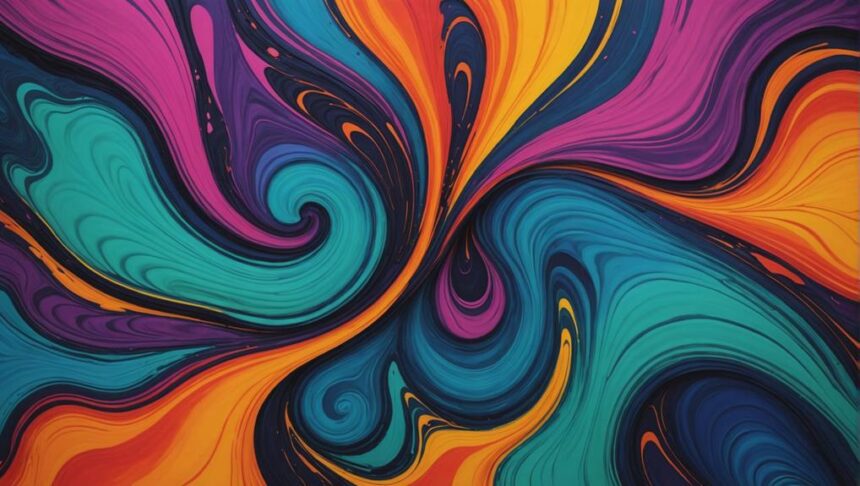
Leave a Reply